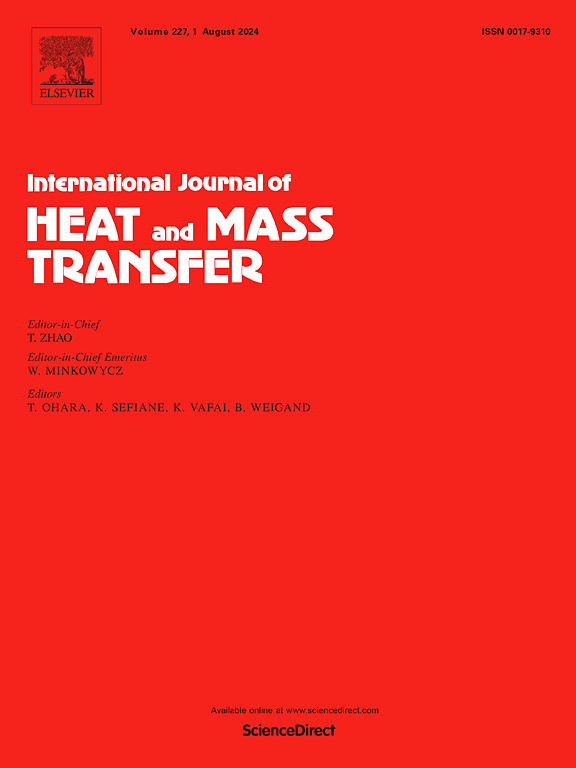横向振动下超临界压力流体在圆管内的强化传热机理
IF 5.8
2区 工程技术
Q1 ENGINEERING, MECHANICAL
International Journal of Heat and Mass Transfer
Pub Date : 2025-06-03
DOI:10.1016/j.ijheatmasstransfer.2025.127259
引用次数: 0
摘要
尽管振动激励在影响超临界压力流体的流动和传热特性方面具有重要的研究价值,但其潜在的机制仍然知之甚少。本文采用大涡模拟(LES)方法研究了整体振动激励对管道内超临界压力流体流动和换热特性的影响。研究重点是分析其对典型换热恶化事件的抑制作用,旨在阐明物性变化和振动激励耦合导致换热增强的基本机制。结果表明,由振动惯性力产生的近壁流向涡片结构(SVS)和由涡倾斜产生的普朗特第三类二次流是强化换热的关键机制。流向涡度和湍流动能的输运方程概述了这两种流动发生所需的条件:前者是通过振动惯性生成在伪临界温度附近的高径向密度梯度层内周期性产生的。后者源于提升机制的增强,这有利于湍流的自我维持恢复。由于SVS的夹带作用,向流涡旋的倾斜和变形增加,导致湍流二次流的形成。结果表明,在密度分层较强的管道流动中,施加横向振动激励可以诱导湍流二次流动。这构成了一种维持湍流二次流的新机制,并为增强湍流传热提供了新的策略。本文章由计算机程序翻译,如有差异,请以英文原文为准。
Heat transfer enhancement mechanism of supercritical pressure fluids in circular pipes under transverse vibration
Although vibrational excitation holds significant research value in influencing the flow and heat transfer characteristics of supercritical pressure fluids, the underlying mechanisms remain poorly understood. In this study, large eddy simulation (LES) is employed to investigate the effects of overall vibrational excitation on the flow and heat transfer characteristics of supercritical pressure fluids within pipes. The research primarily focuses on analyzing its suppressive effect on typical heat transfer deterioration events, aiming to elucidate the fundamental mechanisms by which the coupling of physical property variations and vibrational excitation induces heat transfer enhancement. The results show that near-wall streamwise vortex sheet structures (SVS), generated by vibrational inertial forces, and Prandtl’s third-kind secondary flows, resulting from vortex tilting, are key mechanisms contributing to heat transfer enhancement. Transport equations for streamwise vorticity and turbulent kinetic energy, outline the conditions needed for the occurrence of these two types of flows: the former is periodically generated within the high radial density gradient layer near the pseudocritical temperature through the vibrational inertial generation. The latter arises from the enhancement of the lift-up mechanism, which facilitates the self-sustaining recovery of turbulence. The streamwise vortices experience increased tilting and deformation due to the entrainment action of the SVS, leading to the formation of turbulent secondary flows. The results demonstrate that turbulent secondary flows can be induced by applying transverse vibrational excitation in pipe flows with strong density stratification. This constitutes a novel mechanism for maintaining turbulent secondary flows and provides a new strategy for enhancing turbulent heat transfer.
求助全文
通过发布文献求助,成功后即可免费获取论文全文。
去求助
来源期刊
CiteScore
10.30
自引率
13.50%
发文量
1319
审稿时长
41 days
期刊介绍:
International Journal of Heat and Mass Transfer is the vehicle for the exchange of basic ideas in heat and mass transfer between research workers and engineers throughout the world. It focuses on both analytical and experimental research, with an emphasis on contributions which increase the basic understanding of transfer processes and their application to engineering problems.
Topics include:
-New methods of measuring and/or correlating transport-property data
-Energy engineering
-Environmental applications of heat and/or mass transfer

 求助内容:
求助内容: 应助结果提醒方式:
应助结果提醒方式:


